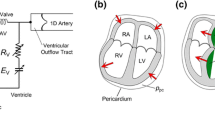Abstract
A simple mathematical model of the intramyocardial circulation has been utilized to provide a better understanding of coronary blood flow. The model includes three myocardial layers, each characterized by a three-parameter windkessel with one capacitance and two resistances. The effects of the beating heart are taken into account by means of an intramyocardial pump and the possible collapse of the vessels by an elevated backpressure. The three basic parameters that govern the flow are a normalized time constant,\(\bar \tau \), the total resistance, Rt, and a parameter, α, which specifies the resistance distribution in the intramyocardial circulation. Both the normal beating heart and prolonged diastole have been investigated analytically as well as numerically. It is shown that each of these parameters has its own special significance. Calculated pressure-flow relationships and zero-flow pressures for the case of prolonged diastole show a high sensitivity to\(\bar \tau \) and α.
Similar content being viewed by others
References
Beyar, R.; Sideman, S. Time-dependent coronary blood flow distribution in left ventricular wall. Am. J. Physiol. 252 (Heart Circ. Physiol. 21):H417-H433; 1987.
Bellamy, R.F. Diastolic coronary artery pressure-flow relations in the dog. Circ. Res. 43:92–101; 1978.
Burratini, R.; Sipkema, P.; van Huis, G.A.; Westerhof, N. Identification of canine coronary resistance and intramyocardial compliance on the basis of the waterfall model. Ann. Biomed. Eng. 13:385–404; 1985.
Dole, W.P.; Cambell, A.B.; Alexander, G.M.; Hixson, E.L.; Bishop, V.S. Physiological interpretation of diastolic coronary artery pressure-flow relationships in the canine coronary bed. In: Mates, R.E.; Nerem, R.M.; Stein, P.D., eds. Mechanics of the coronary circulation. New York: American Society of Mechanical Engineers; 1983: pp. 27–30.
Downey; J.M.; Kirk, E.S. Inhibition of coronary blood flow by a vascular waterfall mechanism. Circ. Res. 36:753–760; 1975.
Eng, C.; Jentzer, J.H.; Kirk, E.S. The effects of the coronary capacitance on the interpretation of diastolic pressure-flow relationships. Circ. Res. 50:334–341; 1982.
Richards, K.L.; Hartley, C.J.; Cannon, S. Usefulness of Doppler catheters in assessment of coronary artery blood flow. In: Spencer, M.P., ed. Cardiac Doppler diagnosis. Boston, MA: Martinus Nijhoff; 1983: pp. 91–97.
Hoffman, J.I.E.; Baer, R.W.; Hanley, F.L.; Messina, L.M. Regulation of transmural myocardial blood flow. ASME J. Biomech. Eng. 107:2–9; 1985.
Hori, S. Comments to (6). Circ Res. 51:819–820; 1982.
Kajiya, F.; Tsujioka, K.; Goto, M.; Wada, Y.; Chen, X.; Nakai, M.; Tadaoka, S.; Hiramatsu, O.; Ogasawara, Y.; Mito, K.; Tomonaga, G. Functional characteristics of intramyocardial capacitance vessels during diastole in the dog. Circ. Res. 58:476–485; 1986.
Klocke, F.J.; Mates, R.E.; Canty, J.M.; Ellis, A.K. Coronary pressure-flow relationships, controversial issues and probable implications. Circ. Res. 56:310–323; 1985.
Lee, J.; Chambers, D.E.; Akizuki, S.; Downey, J.M. The role of vascular capacitance in the coronary arteries. Circ. Res. 55:751–762; 1984.
Panerai, R.B.; Chamberlain, J.H.; Ayers, B. McA. Characterization of the extravascular component of coronary resistance by instantaneous pressure-flow relationships in the dog. Circ. Res. 45:378–390; 1979.
Permutt, S.; Riley, R.I. Hemodynamics of collapsible vessels with tone: The vascular waterfall. J. Appl. Physiol. 18:924–932; 1963.
Reneman, R.S.; Arts, R. Dynamic capacitance of epicardial coronary arteries in vivo. ASME J. Biomech. Eng. 107:29–33; 1985.
Spaan, J.A.E.; Breuls, N.P.W.; Laird, J.D. Diastolic-systolic coronary flow differences are caused by intramyocardial pump action in the anesthetized dog. Circ. Res. 49:584–593; 1981.
Spaan, J.A.E. Coronary diastolic pressure-flow relation and zero flow pressure explained on the basis of intramyocardial compliance. Circ. Res. 56:293–304; 1985.
Wiesner, T.F.; Levesque, M.J.; Rooz, E.; Nerem, R.M. Epicardial coronary blood flow including the presence of stenoses and aorto-coronary bypasses—II: Experimental comparison and parametric investigations. ASME J. Biomech. Eng. 110:144–149; 1988.
Author information
Authors and Affiliations
Rights and permissions
About this article
Cite this article
Holenstein, R., Nerem, R.M. Parametric analysis of flow in the intramyocardial circulation. Ann Biomed Eng 18, 347–365 (1990). https://doi.org/10.1007/BF02364154
Received:
Revised:
Issue Date:
DOI: https://doi.org/10.1007/BF02364154




